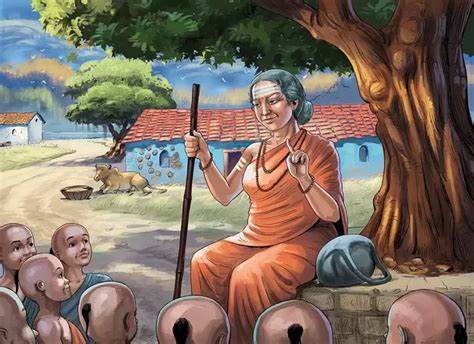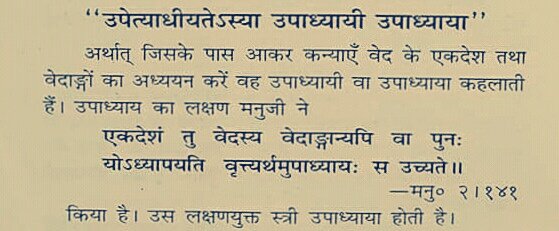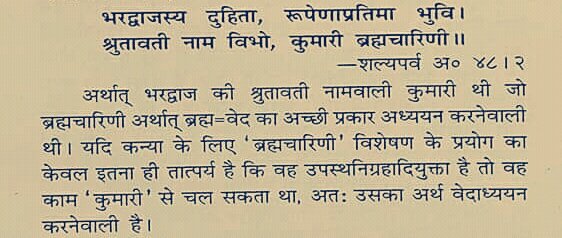Is it true that Women are not allowed to read Vedas?
The Veda is for all human beings. Vedas are the voice of almighty Ishwara. Just as the earth, water, air, sun, sky are created by Ishwara and is for all human beings, similarly Veda is also for all human beings.
The Veda is for all human beings. Vedas are the voice of almighty Ishwara. Just as the earth, water, air, sun, sky are created by Ishwara and is for all human beings, similarly Veda is also for all human beings.
Yajurveda 26/2 clearly states that Vedas are for all human beings. It says- “यथेमां वाचं कल्याणीमवदानि जनेभ्यः।
"I do hereby address this salutary speech (Veda) for the benefit of humanity."
"I do hereby address this salutary speech (Veda) for the benefit of humanity."
Veda praises a scholarly daughter n says: A girl also should be brought up and educated with great effort n care. The imp. of a girl’s education is stressed in the अथर्ववेद which states, Success of woman in her married life depends upon her proper training during the ब्रह्मचर्य.
The girls were entitled to Upanayana and to the privilege of studying Vedas; just as the boys. Women performed धार्मिक rites after completing their education under a Guru. यम स्मृति state that— In ancient times, Women used to have "उपनयन संस्कार" they also studied the Veda.
In the Harita Dharmasutra, women were divided into two classes:
1. Brahmavadinis- तत्र ब्रह्मवादिनीनाम् उपनयनं अग्निबधनं वेदाध्ययनं स्वगृहे भिक्षा इति। Brahmavadini was a woman who studied the vedas after the यज्ञोपवीत संस्कार and got married later or stayed a bachelor.
1. Brahmavadinis- तत्र ब्रह्मवादिनीनाम् उपनयनं अग्निबधनं वेदाध्ययनं स्वगृहे भिक्षा इति। Brahmavadini was a woman who studied the vedas after the यज्ञोपवीत संस्कार and got married later or stayed a bachelor.
Brahmavadini literally means ‘the woman who speaks about Brahman’. ब्रह्मवादिनी whose उपनयन संस्कार has been carried out are required to perform Yajna, study the Vedas and those who conduct themselves in bhiksha vritti.
Maitreyi, wife of the Yajnavalkya was also a Brahmavadini.
Maitreyi, wife of the Yajnavalkya was also a Brahmavadini.
2. Sadyovadhus- सद्योबधूनां तू उपस्थिते विवाहे कथंचित् उपनयनं कृत्वा विवाहः कार्यः। Sadyovadhu was a woman who got married or become वधु immediately after her upnayana on the attainment of puberty, without undergoing the वैदिक शिक्षा in the गुरुकुल.
Madhava Samhite on Parashara Smriti says:
||yopanayanam krutwa pashcad vivaham karoti sa brahmavadini |
tathaiva ya prathamata upanayanam krutwa sadya eva vivaham vidhaya tato vedamadhite sa sadyovadhuh||
||yopanayanam krutwa pashcad vivaham karoti sa brahmavadini |
tathaiva ya prathamata upanayanam krutwa sadya eva vivaham vidhaya tato vedamadhite sa sadyovadhuh||
Which Means: "She who studies the Vedas after upanayana and then gets married is Brahmavadini, she who gets married immediately after upanayana and then studies vedas is Sadyovadhu."
There is a clear mention in the Mahabhashya about women being "pandita" in the scriptures. e.g. it is mentioned in the mahabhashya of "इडशच" 3 | 3 | 21.
Vedic Rishikas
Rishikaas are also मंत्रदृष्टा. Lopamudra, Gargi, Maitreyi etc. are many historically famous rishikaas. The prominent among them were Lopamudra, Vishwawara, Sikta, Ghosha and Maitreyi. https://twitter.com/vedicvishal/status/1202147253005115394?s=19
Rishikaas are also मंत्रदृष्टा. Lopamudra, Gargi, Maitreyi etc. are many historically famous rishikaas. The prominent among them were Lopamudra, Vishwawara, Sikta, Ghosha and Maitreyi. https://twitter.com/vedicvishal/status/1202147253005115394?s=19
Maitreyi, (the wife of Yajnavalkya) is accredited with about ten hymns in Rig Veda.
Lopamudra was the wife of the sage Agastya. A hymn in the Rigveda is attributed to her.
Lopamudra was the wife of the sage Agastya. A hymn in the Rigveda is attributed to her.
Let's see what Itihasa says about it.
1.) Ramayana(Ayodhya kaand), Kaushalya used to perform Agnihotra.
सा क्षौमवसना हृष्टा नित्यं व्रतपरायणा।
अग्निं जुहोति स्म तदा मन्त्रवत्कृतमङ्गला॥ 2.20.15 ॥
1.) Ramayana(Ayodhya kaand), Kaushalya used to perform Agnihotra.
सा क्षौमवसना हृष्टा नित्यं व्रतपरायणा।
अग्निं जुहोति स्म तदा मन्त्रवत्कृतमङ्गला॥ 2.20.15 ॥
Always engaged in the observance of vows, Kausalya (then) clad in silk cloth was performing rituals of auspiciousness, offering oblations to the firegod in accordance with mantras (Vedic hymns).
Highminded mother Kausalya, her anguish subdued, performed the sipping rite (achamana) and her self rendered pure, performed auspicious ceremonies for Rama.
साऽवनीय तमायासमुपस्पृश्य जलं शुचिः।
चकार माता रामस्य मङ्गलानि मनस्विनी।।2.25.1।
साऽवनीय तमायासमुपस्पृश्य जलं शुचिः।
चकार माता रामस्य मङ्गलानि मनस्विनी।।2.25.1।
Sita's Sandhya Vandan:
Hanuman went to Ashoka garden looking for Sita in Lanka, but he did not find Sita. Hanuman saw a holy water river there. Hanuman was sure that if Sita would be here, she would definitely come here to offer her Sandhya vandan.
Hanuman went to Ashoka garden looking for Sita in Lanka, but he did not find Sita. Hanuman saw a holy water river there. Hanuman was sure that if Sita would be here, she would definitely come here to offer her Sandhya vandan.
सन्ध्याकालमनाः श्यामा ध्रुवमेष्यति जानकी।
नदीं चेमां शुभजलां सन्ध्यार्थे वरवर्णिनी॥5.14.49॥
Surely that lady of lovely complexion, the beautiful Janaki will come to this river
flowing with sacred waters for performing the evening rituals.
नदीं चेमां शुभजलां सन्ध्यार्थे वरवर्णिनी॥5.14.49॥
Surely that lady of lovely complexion, the beautiful Janaki will come to this river
flowing with sacred waters for performing the evening rituals.
2.) In the Mahabharata, the description of a Brahmini named Shiva, Siddha, Shrimati and Shrutavati is found in the following words.
So, denying the women rights to study vedic knowledge, to Yajnopavitam Samskara and Veda Adayayan is un-vedic. In the vedas there is not a single reference which denies the women these rights.
|| कृण्वन्तो विश्वमार्यम् ||
|| कृण्वन्तो विश्वमार्यम् ||

 Read on Twitter
Read on Twitter










